Motives for Starbucks' Joint Venture in India
VerifiedAdded on 2023/01/31
|6
|1614
|85
AI Summary
This report investigates the reasons for Starbucks' expansion in the Indian market through joint ventures instead of acquiring and licensing. It evaluates the motives behind the decision and provides concluding remarks and recommendations.
Contribute Materials
Your contribution can guide someone’s learning journey. Share your
documents today.
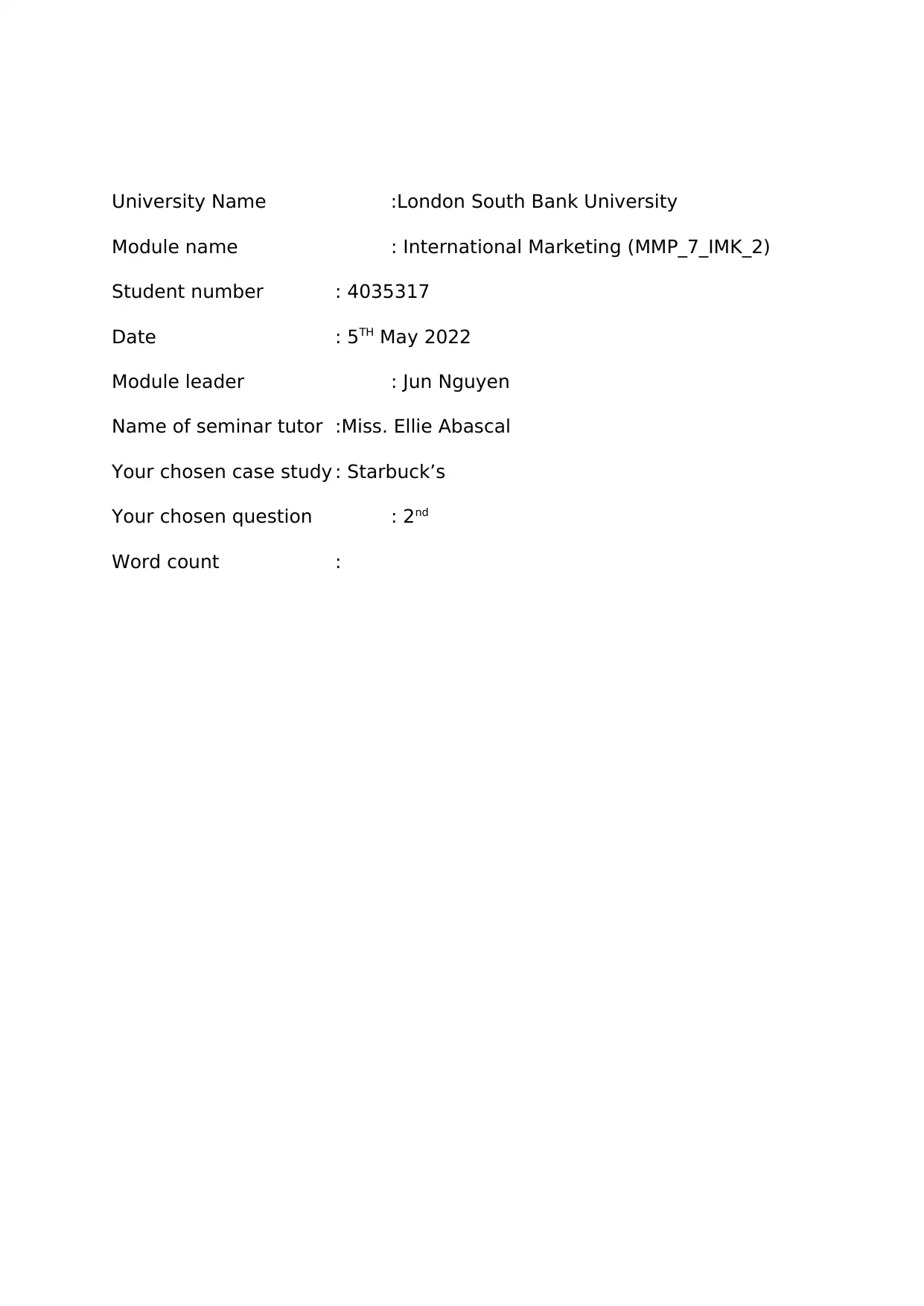
University Name :London South Bank University
Module name : International Marketing (MMP_7_IMK_2)
Student number : 4035317
Date : 5TH May 2022
Module leader : Jun Nguyen
Name of seminar tutor :Miss. Ellie Abascal
Your chosen case study : Starbuck’s
Your chosen question : 2nd
Word count :
Module name : International Marketing (MMP_7_IMK_2)
Student number : 4035317
Date : 5TH May 2022
Module leader : Jun Nguyen
Name of seminar tutor :Miss. Ellie Abascal
Your chosen case study : Starbuck’s
Your chosen question : 2nd
Word count :
Secure Best Marks with AI Grader
Need help grading? Try our AI Grader for instant feedback on your assignments.
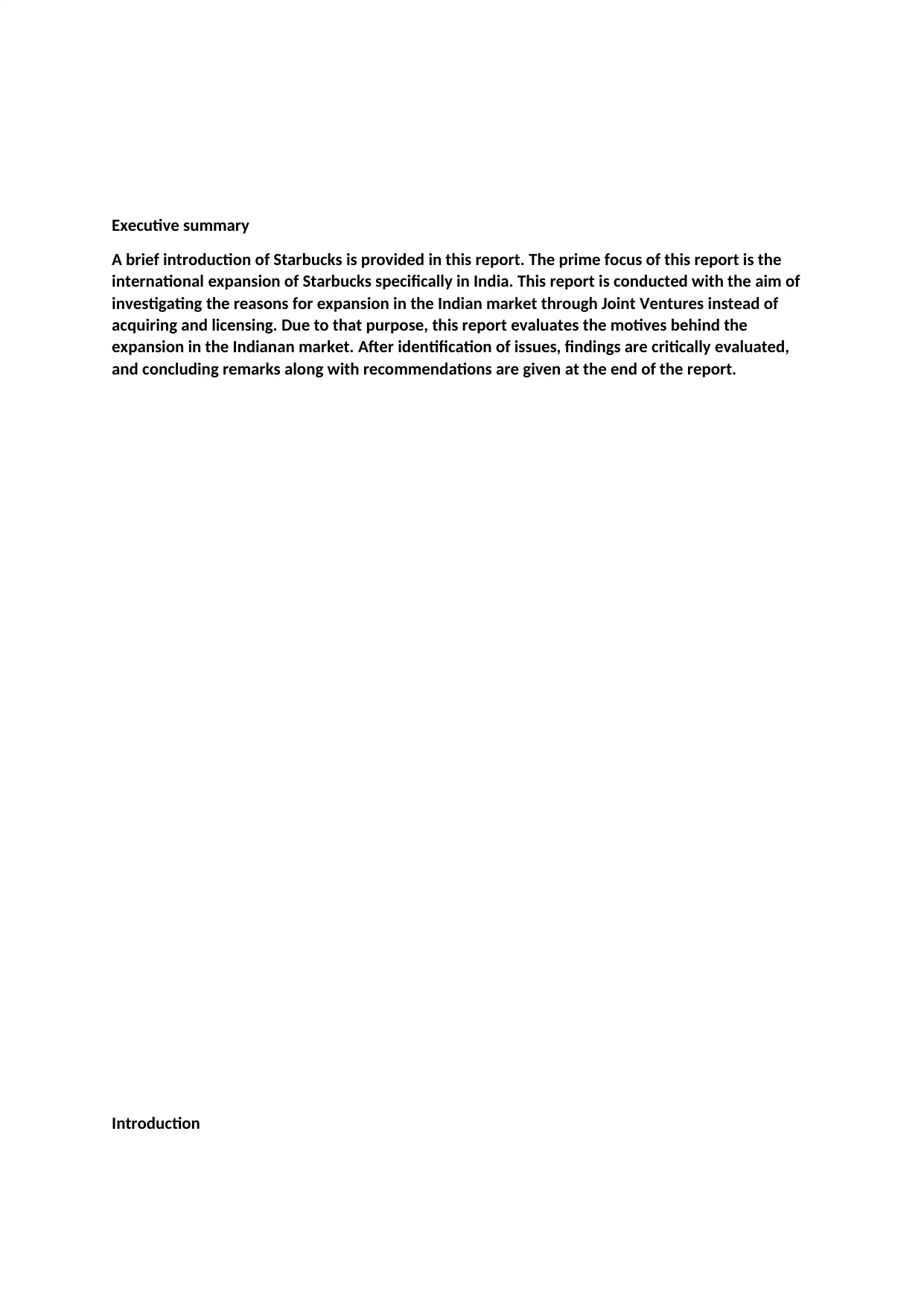
Executive summary
A brief introduction of Starbucks is provided in this report. The prime focus of this report is the
international expansion of Starbucks specifically in India. This report is conducted with the aim of
investigating the reasons for expansion in the Indian market through Joint Ventures instead of
acquiring and licensing. Due to that purpose, this report evaluates the motives behind the
expansion in the Indianan market. After identification of issues, findings are critically evaluated,
and concluding remarks along with recommendations are given at the end of the report.
Introduction
A brief introduction of Starbucks is provided in this report. The prime focus of this report is the
international expansion of Starbucks specifically in India. This report is conducted with the aim of
investigating the reasons for expansion in the Indian market through Joint Ventures instead of
acquiring and licensing. Due to that purpose, this report evaluates the motives behind the
expansion in the Indianan market. After identification of issues, findings are critically evaluated,
and concluding remarks along with recommendations are given at the end of the report.
Introduction
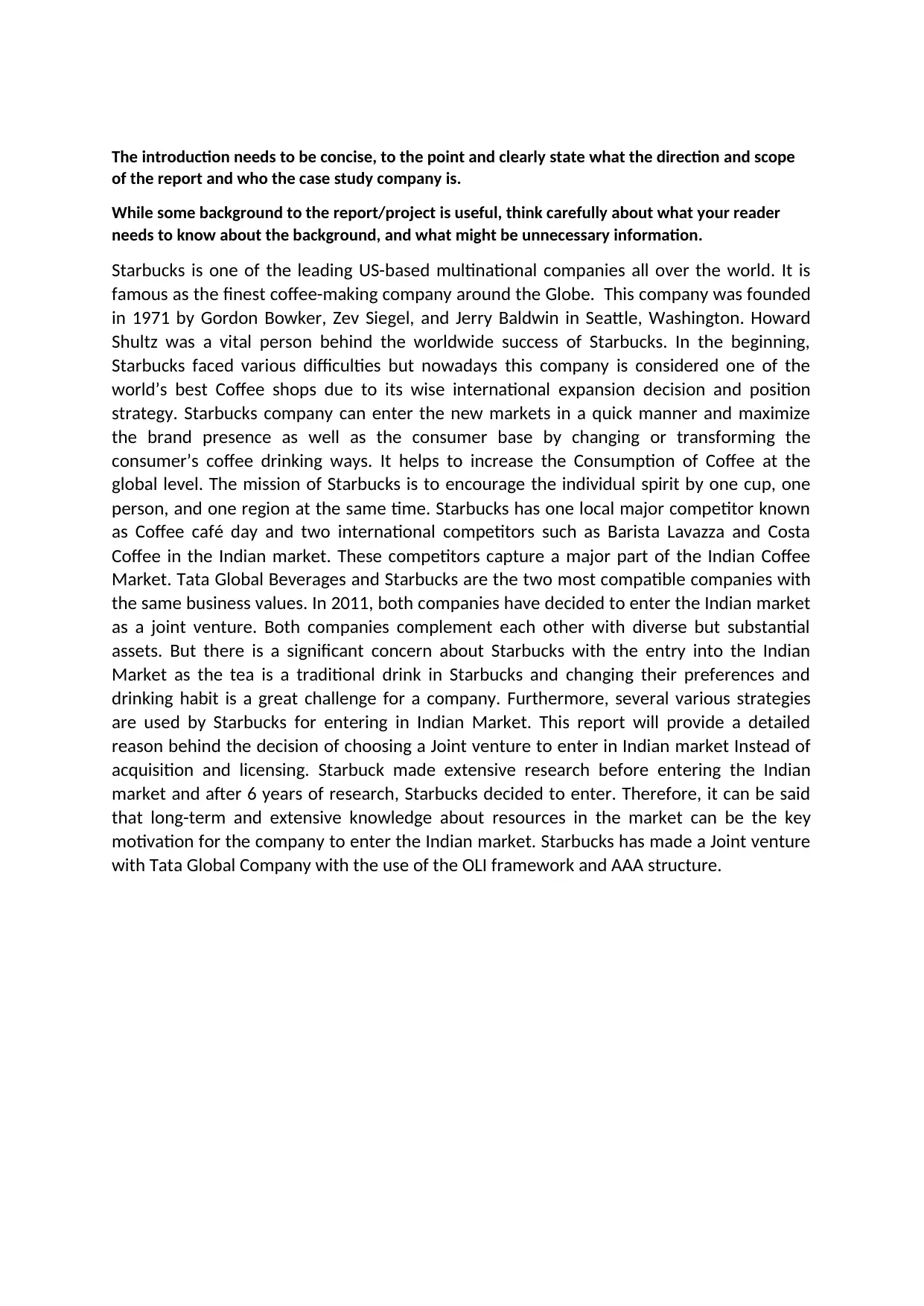
The introduction needs to be concise, to the point and clearly state what the direction and scope
of the report and who the case study company is.
While some background to the report/project is useful, think carefully about what your reader
needs to know about the background, and what might be unnecessary information.
Starbucks is one of the leading US-based multinational companies all over the world. It is
famous as the finest coffee-making company around the Globe. This company was founded
in 1971 by Gordon Bowker, Zev Siegel, and Jerry Baldwin in Seattle, Washington. Howard
Shultz was a vital person behind the worldwide success of Starbucks. In the beginning,
Starbucks faced various difficulties but nowadays this company is considered one of the
world’s best Coffee shops due to its wise international expansion decision and position
strategy. Starbucks company can enter the new markets in a quick manner and maximize
the brand presence as well as the consumer base by changing or transforming the
consumer’s coffee drinking ways. It helps to increase the Consumption of Coffee at the
global level. The mission of Starbucks is to encourage the individual spirit by one cup, one
person, and one region at the same time. Starbucks has one local major competitor known
as Coffee café day and two international competitors such as Barista Lavazza and Costa
Coffee in the Indian market. These competitors capture a major part of the Indian Coffee
Market. Tata Global Beverages and Starbucks are the two most compatible companies with
the same business values. In 2011, both companies have decided to enter the Indian market
as a joint venture. Both companies complement each other with diverse but substantial
assets. But there is a significant concern about Starbucks with the entry into the Indian
Market as the tea is a traditional drink in Starbucks and changing their preferences and
drinking habit is a great challenge for a company. Furthermore, several various strategies
are used by Starbucks for entering in Indian Market. This report will provide a detailed
reason behind the decision of choosing a Joint venture to enter in Indian market Instead of
acquisition and licensing. Starbuck made extensive research before entering the Indian
market and after 6 years of research, Starbucks decided to enter. Therefore, it can be said
that long-term and extensive knowledge about resources in the market can be the key
motivation for the company to enter the Indian market. Starbucks has made a Joint venture
with Tata Global Company with the use of the OLI framework and AAA structure.
of the report and who the case study company is.
While some background to the report/project is useful, think carefully about what your reader
needs to know about the background, and what might be unnecessary information.
Starbucks is one of the leading US-based multinational companies all over the world. It is
famous as the finest coffee-making company around the Globe. This company was founded
in 1971 by Gordon Bowker, Zev Siegel, and Jerry Baldwin in Seattle, Washington. Howard
Shultz was a vital person behind the worldwide success of Starbucks. In the beginning,
Starbucks faced various difficulties but nowadays this company is considered one of the
world’s best Coffee shops due to its wise international expansion decision and position
strategy. Starbucks company can enter the new markets in a quick manner and maximize
the brand presence as well as the consumer base by changing or transforming the
consumer’s coffee drinking ways. It helps to increase the Consumption of Coffee at the
global level. The mission of Starbucks is to encourage the individual spirit by one cup, one
person, and one region at the same time. Starbucks has one local major competitor known
as Coffee café day and two international competitors such as Barista Lavazza and Costa
Coffee in the Indian market. These competitors capture a major part of the Indian Coffee
Market. Tata Global Beverages and Starbucks are the two most compatible companies with
the same business values. In 2011, both companies have decided to enter the Indian market
as a joint venture. Both companies complement each other with diverse but substantial
assets. But there is a significant concern about Starbucks with the entry into the Indian
Market as the tea is a traditional drink in Starbucks and changing their preferences and
drinking habit is a great challenge for a company. Furthermore, several various strategies
are used by Starbucks for entering in Indian Market. This report will provide a detailed
reason behind the decision of choosing a Joint venture to enter in Indian market Instead of
acquisition and licensing. Starbuck made extensive research before entering the Indian
market and after 6 years of research, Starbucks decided to enter. Therefore, it can be said
that long-term and extensive knowledge about resources in the market can be the key
motivation for the company to enter the Indian market. Starbucks has made a Joint venture
with Tata Global Company with the use of the OLI framework and AAA structure.

Critically evaluate the motives underlying Starbucks’ decision to use a joint venture to expand to
India rather than licensing or acquisitions?
At present, companies have focused to expand their business activities and operation
outside the national boundaries. Companies are increasingly expanding their operations
beyond their national borders by relocating their chain value outside the national borders.
There are various reasons that motivate the company to do so. For example, companies
may want to acquire more attractive strategic as well as natural resources in form of
physical, human, and technological resources. But on the other hand, maybe companies
have only focused on maximizing their customer level. Moreover, companies believe that
they sell more services and products internationally and gained more recognition as
compared to the home market. Regardless of all these types of advantages, it is essential for
companies to formulate and execute a holistic approach to internationalization. There are
several entry-mode strategies such as acquisition, licensing strategic alliances, and
franchises that can be used by the companies to expand their business in abroad. But it
should be noticed that every strategy has different merits and demerits as well.
Therefore, the OLI framework which is also called an eclectic paradigm can be helpful for
identifying the best option for companies. OLI stands for Ownership, Location, and
Internationalization benefits and is based on three -a tiered evaluation model. This
approach emphasizes the fact that the company can effectively engage with foreign direct
Investment through these three advantages. If any one of these three advantages is missing,
then the company should move to another strategy.
In this report, OLI Framework is used to understand and evaluate the reason behind the
Joint venture between Starbucks company and Tata Global Beverages. OLI framework helps
companies evaluate the competitive advantages resulting from internationalization and
guides expansion to foreign markets.
According to the assumption made by the OLI model or eclectic paradigm, companies will
never go to the open market if the cost of the same transaction is lower in-house as
compared to the outside. This OLI framework was firstly introduced by John, H. Dunning in
1979 and it is based on internationalization theory. The ownership, location, and
internationalization advantages are considered the considerable variable that can
determine the company’s activities at the international level (Dunning,2000). The
internationalization of Starbucks in India is particularly related to this model because it also
helps to find out the company’s overall internal strengths that will be utilized to reveal the
motives for the joint venture with Tata Global Company by implying the OLI framework.
Ownership Advantages of Starbucks in the
Indian Market
Location Advantages of Starbucks in the
India rather than licensing or acquisitions?
At present, companies have focused to expand their business activities and operation
outside the national boundaries. Companies are increasingly expanding their operations
beyond their national borders by relocating their chain value outside the national borders.
There are various reasons that motivate the company to do so. For example, companies
may want to acquire more attractive strategic as well as natural resources in form of
physical, human, and technological resources. But on the other hand, maybe companies
have only focused on maximizing their customer level. Moreover, companies believe that
they sell more services and products internationally and gained more recognition as
compared to the home market. Regardless of all these types of advantages, it is essential for
companies to formulate and execute a holistic approach to internationalization. There are
several entry-mode strategies such as acquisition, licensing strategic alliances, and
franchises that can be used by the companies to expand their business in abroad. But it
should be noticed that every strategy has different merits and demerits as well.
Therefore, the OLI framework which is also called an eclectic paradigm can be helpful for
identifying the best option for companies. OLI stands for Ownership, Location, and
Internationalization benefits and is based on three -a tiered evaluation model. This
approach emphasizes the fact that the company can effectively engage with foreign direct
Investment through these three advantages. If any one of these three advantages is missing,
then the company should move to another strategy.
In this report, OLI Framework is used to understand and evaluate the reason behind the
Joint venture between Starbucks company and Tata Global Beverages. OLI framework helps
companies evaluate the competitive advantages resulting from internationalization and
guides expansion to foreign markets.
According to the assumption made by the OLI model or eclectic paradigm, companies will
never go to the open market if the cost of the same transaction is lower in-house as
compared to the outside. This OLI framework was firstly introduced by John, H. Dunning in
1979 and it is based on internationalization theory. The ownership, location, and
internationalization advantages are considered the considerable variable that can
determine the company’s activities at the international level (Dunning,2000). The
internationalization of Starbucks in India is particularly related to this model because it also
helps to find out the company’s overall internal strengths that will be utilized to reveal the
motives for the joint venture with Tata Global Company by implying the OLI framework.
Ownership Advantages of Starbucks in the
Indian Market
Location Advantages of Starbucks in the
Secure Best Marks with AI Grader
Need help grading? Try our AI Grader for instant feedback on your assignments.
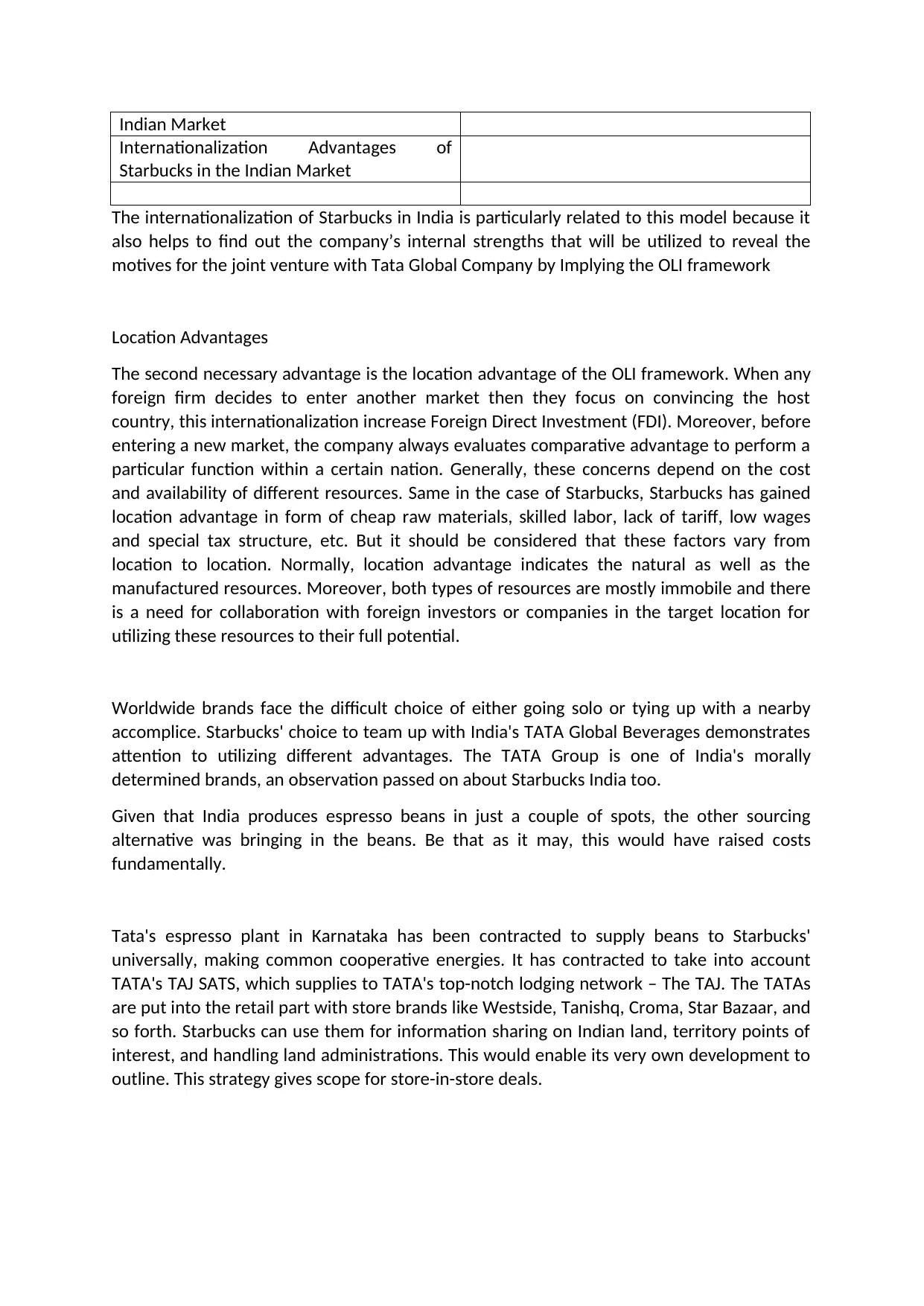
Indian Market
Internationalization Advantages of
Starbucks in the Indian Market
The internationalization of Starbucks in India is particularly related to this model because it
also helps to find out the company’s internal strengths that will be utilized to reveal the
motives for the joint venture with Tata Global Company by Implying the OLI framework
Location Advantages
The second necessary advantage is the location advantage of the OLI framework. When any
foreign firm decides to enter another market then they focus on convincing the host
country, this internationalization increase Foreign Direct Investment (FDI). Moreover, before
entering a new market, the company always evaluates comparative advantage to perform a
particular function within a certain nation. Generally, these concerns depend on the cost
and availability of different resources. Same in the case of Starbucks, Starbucks has gained
location advantage in form of cheap raw materials, skilled labor, lack of tariff, low wages
and special tax structure, etc. But it should be considered that these factors vary from
location to location. Normally, location advantage indicates the natural as well as the
manufactured resources. Moreover, both types of resources are mostly immobile and there
is a need for collaboration with foreign investors or companies in the target location for
utilizing these resources to their full potential.
Worldwide brands face the difficult choice of either going solo or tying up with a nearby
accomplice. Starbucks' choice to team up with India's TATA Global Beverages demonstrates
attention to utilizing different advantages. The TATA Group is one of India's morally
determined brands, an observation passed on about Starbucks India too.
Given that India produces espresso beans in just a couple of spots, the other sourcing
alternative was bringing in the beans. Be that as it may, this would have raised costs
fundamentally.
Tata's espresso plant in Karnataka has been contracted to supply beans to Starbucks'
universally, making common cooperative energies. It has contracted to take into account
TATA's TAJ SATS, which supplies to TATA's top-notch lodging network – The TAJ. The TATAs
are put into the retail part with store brands like Westside, Tanishq, Croma, Star Bazaar, and
so forth. Starbucks can use them for information sharing on Indian land, territory points of
interest, and handling land administrations. This would enable its very own development to
outline. This strategy gives scope for store-in-store deals.
Internationalization Advantages of
Starbucks in the Indian Market
The internationalization of Starbucks in India is particularly related to this model because it
also helps to find out the company’s internal strengths that will be utilized to reveal the
motives for the joint venture with Tata Global Company by Implying the OLI framework
Location Advantages
The second necessary advantage is the location advantage of the OLI framework. When any
foreign firm decides to enter another market then they focus on convincing the host
country, this internationalization increase Foreign Direct Investment (FDI). Moreover, before
entering a new market, the company always evaluates comparative advantage to perform a
particular function within a certain nation. Generally, these concerns depend on the cost
and availability of different resources. Same in the case of Starbucks, Starbucks has gained
location advantage in form of cheap raw materials, skilled labor, lack of tariff, low wages
and special tax structure, etc. But it should be considered that these factors vary from
location to location. Normally, location advantage indicates the natural as well as the
manufactured resources. Moreover, both types of resources are mostly immobile and there
is a need for collaboration with foreign investors or companies in the target location for
utilizing these resources to their full potential.
Worldwide brands face the difficult choice of either going solo or tying up with a nearby
accomplice. Starbucks' choice to team up with India's TATA Global Beverages demonstrates
attention to utilizing different advantages. The TATA Group is one of India's morally
determined brands, an observation passed on about Starbucks India too.
Given that India produces espresso beans in just a couple of spots, the other sourcing
alternative was bringing in the beans. Be that as it may, this would have raised costs
fundamentally.
Tata's espresso plant in Karnataka has been contracted to supply beans to Starbucks'
universally, making common cooperative energies. It has contracted to take into account
TATA's TAJ SATS, which supplies to TATA's top-notch lodging network – The TAJ. The TATAs
are put into the retail part with store brands like Westside, Tanishq, Croma, Star Bazaar, and
so forth. Starbucks can use them for information sharing on Indian land, territory points of
interest, and handling land administrations. This would enable its very own development to
outline. This strategy gives scope for store-in-store deals.
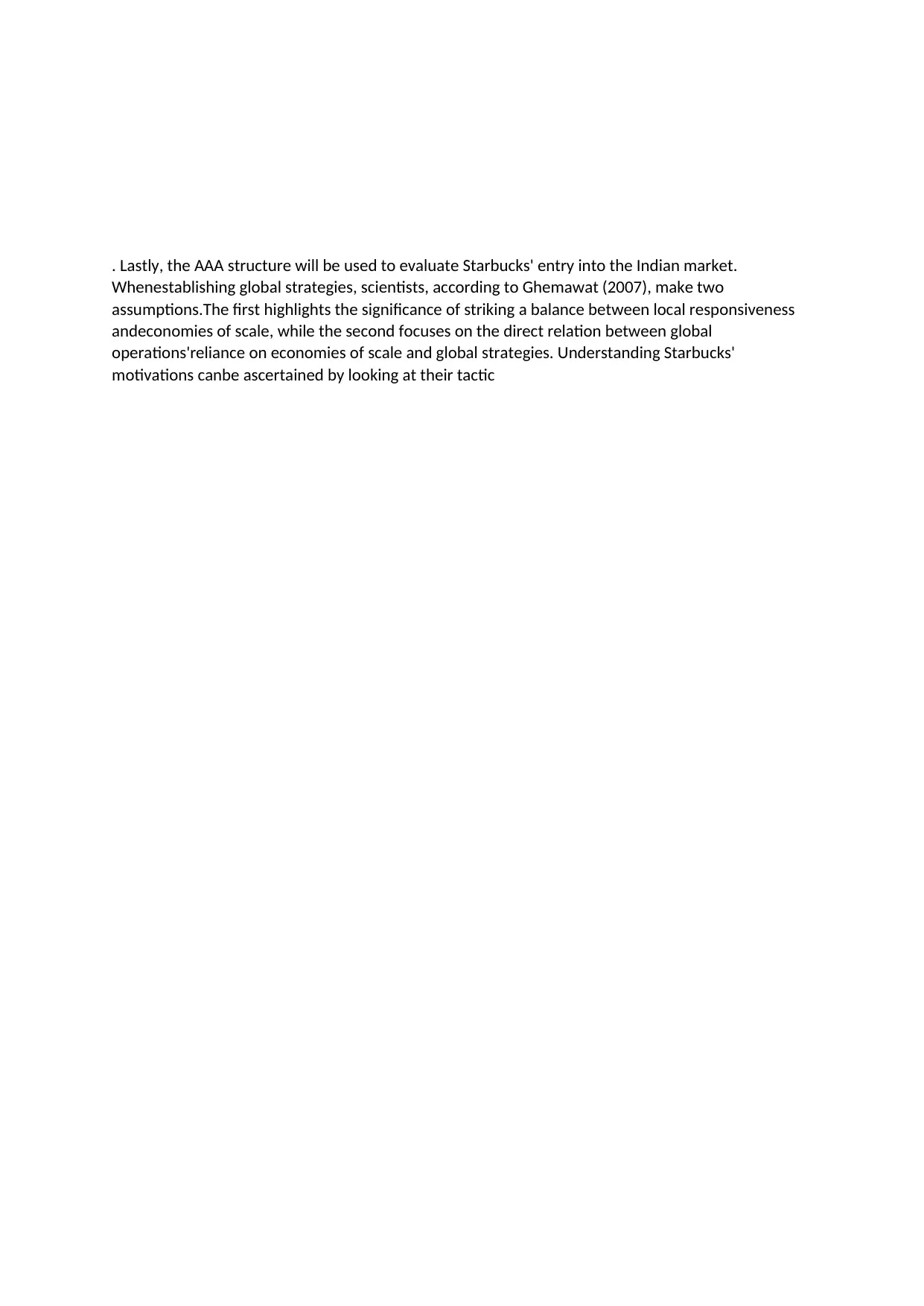
. Lastly, the AAA structure will be used to evaluate Starbucks' entry into the Indian market.
Whenestablishing global strategies, scientists, according to Ghemawat (2007), make two
assumptions.The first highlights the significance of striking a balance between local responsiveness
andeconomies of scale, while the second focuses on the direct relation between global
operations'reliance on economies of scale and global strategies. Understanding Starbucks'
motivations canbe ascertained by looking at their tactic
Whenestablishing global strategies, scientists, according to Ghemawat (2007), make two
assumptions.The first highlights the significance of striking a balance between local responsiveness
andeconomies of scale, while the second focuses on the direct relation between global
operations'reliance on economies of scale and global strategies. Understanding Starbucks'
motivations canbe ascertained by looking at their tactic
1 out of 6
Related Documents
Your All-in-One AI-Powered Toolkit for Academic Success.
+13062052269
info@desklib.com
Available 24*7 on WhatsApp / Email
![[object Object]](/_next/static/media/star-bottom.7253800d.svg)
Unlock your academic potential
© 2024 | Zucol Services PVT LTD | All rights reserved.





